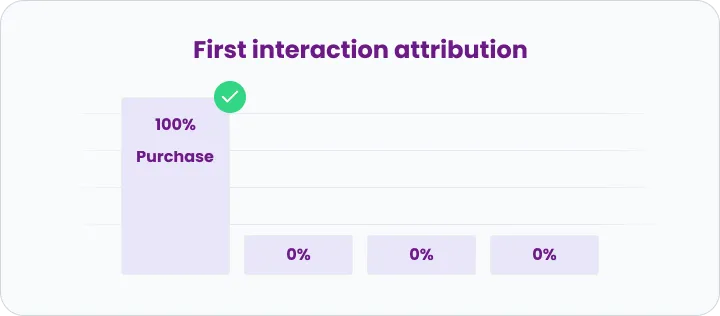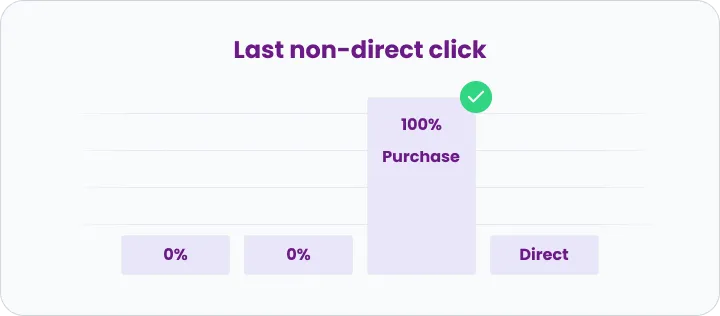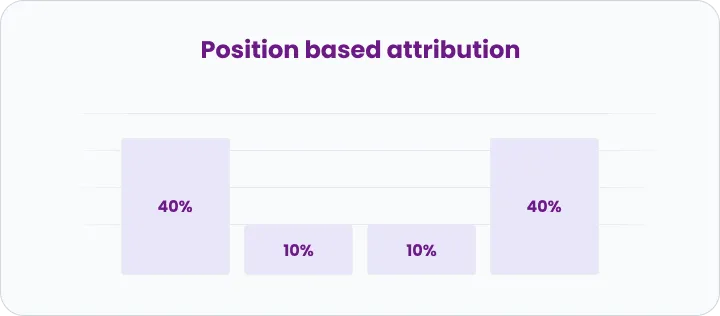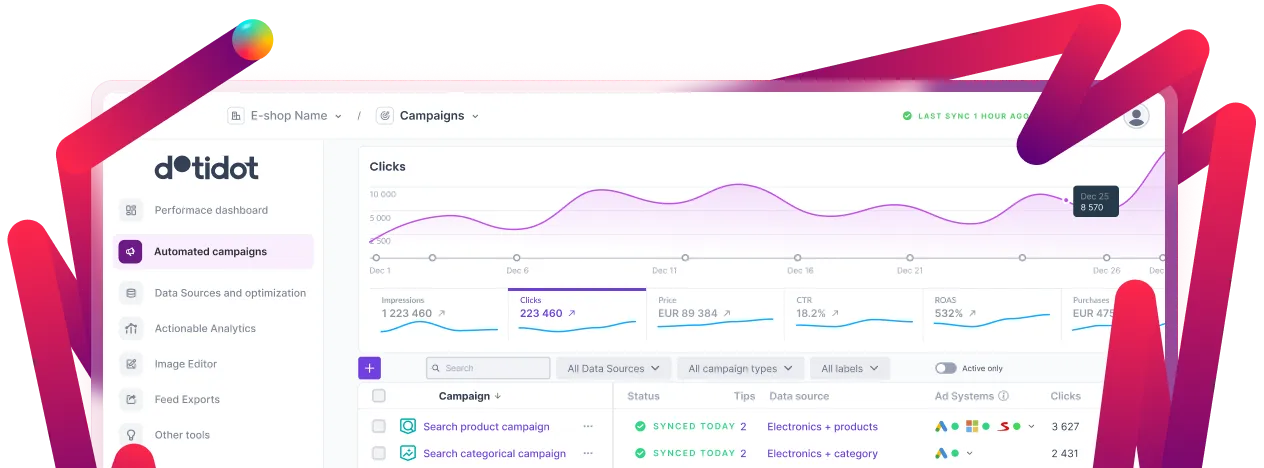Book a call with us







Typically, customers encounter a brand multiple times before making a purchase. They may see various campaigns and visit your website several times through different channels. Determining which channel or campaign had the biggest impact can be challenging.
This is where marketing attribution comes in.
As hinted in the previous paragraphs, marketing attribution helps you identify the user journey before the conversion occurred. It evaluates each step of the journey based on the chosen model.
Some attribution models focus solely on the beginning or end of the customer journey, while others evaluate all the channels involved.
Understanding the differences between these models can help you choose the one that best fits your marketing goals and provides the most accurate insights into your customers' behavior
While knowing the difference between single-touch and multi-touch attribution is important, it is even more crucial to understand the details of each attribution model.
Let's dive into it.
The first-touch attribution model assigns 100% of the credit for a conversion to the first interaction with a customer. This model emphasizes the initial point of contact as the most influential in driving a customer to make a purchase.

Example: Imagine John sees an ad on Facebook, clicks on it, and reads the parameters about a laptop he is interested in. He returns a second time via a direct channel to learn more, and then, on the third visit, a remarketing campaign hits him, and he finally buys the laptop. In this model, the Facebook ad gets all the credit for the sale.
Pros and cons: This model is easy to understand and provides clear insight into which channels are effective at capturing initial interest. But this oversimplification ignores the subsequent interactions and is not suitable for complex user journeys.
When to use: This model is useful for brand awareness campaigns to measure the top-of-the-funnel impact or for content marketers to show the value of their content in attracting new prospects. In some cases it also makes sense for performance marketers to optimize budget allocation for channels that drive first interactions
The last-touch attribution model assigns all the credit for a conversion to the final interaction a customer has before making a purchase. This model highlights the importance of the last touchpoint in the customer journey, viewing it as the decisive factor in the conversion process.

Example: Let's stick with John. He sees an ad on Facebook, clicks on it, and reads the parameters about a laptop he is interested in. He returns a second time via a direct channel to learn more, and then, on the third visit, a remarketing campaign hits him, and he finally buys the laptop. Now the remarketing ad receives full credit for the sale.
Pros and cons: Again this model is quite oversimplified. While being easy to understand, it is not ideal for long sales cycles. But it highlights the touchpoints directly responsible for finalizing sales. Which is always good to know.
When to use: It can be useful for marketers to discover if their remarketing campaigns deliver the desired results. It is also a sign which channels effectively convert website visitors to buyers.
The last-non-direct touch assigns all the credit for a conversion to the last interaction a customer has with a brand, excluding direct visits. This model assumes that direct visits often indicate pre-existing intent and thus gives more importance to the last non-direct interaction that guided the customer to convert.

Example: We need to modify John's journey for purchasing a laptop.
In this example, the remarketing ad (point 3) gets all the credit because the last touch came from a direct channel.
Pros and cons: All the benefits and limitations from last-touch apply here too. This model can sometimes bring a more balanced view of the customer journey by excluding direct traffic, which often reflects pre-existing intent. But excluding direct visits can often be tricky and will probably exclude some valid interactions.
When to use: Marketers gain a clear overview of marketing channels, helping them better understand which are most effective.
The position-based attribution model gives credit to several points of contact throughout the customer journey. It focuses on the first and last interactions but also takes into account the impact of interactions that happen in between. Typically, this model assigns 40% credit to both the first and last touchpoints, while the remaining 20% is distributed among the middle interactions.

Example: Imagine John interacts with a brand by first seeing a Facebook ad, then clicking on an organic search result, and finally making a purchase after receiving a promotional email. According to this model:
Pros and cons: Considers multiple touch points throughout the customer journey and fairly distributes the credit to both the first and last interactions, as well as middle interactions, reflecting their roles in the conversion process. This approach can be very subjective though as distribution percentages (40-20-40 percent) may not accurately reflect every business scenario.
When to use: As this is a multi-touch attribution model, it has wide usage ranging from lead nurturing (to understand which touchpoints were effective) to multi-channel campaigns (for evaluating the combined impact of various touchpoints).
The linear model assigns equal credit to every touchpoint in the customer journey. This model treats all interactions as equally important in driving the conversion, giving a balanced view of the entire customer experience.

Example: Consider John, who first sees an ad on Facebook, then clicks on a search result, returns back to learn more via Direct, and finally purchases a laptop after receiving a promotional email. In the linear attribution model, each of these 4 touchpoints would receive 25% of the credit for the sale.
Pros and cons: This fair distribution might provide holistic insights of all of your marketing efforts. But it does not reflect the varying impact of different touchpoints, as some interactions might be more influential than others.
When to use: This view can be useful to CX teams to ensure all part of the customer journey are well optimized. Marketers then can see all channels that somehow contributed to the purchase.
This model assigns more credit to touchpoints that occur closer to the time of conversion. It assumes that the interactions nearer to the purchase are more influential in driving the final decision, gradually decreasing the value of earlier touchpoints.

Example: Imagine John first sees a Facebook ad for a laptop a month ago, clicks on a search result two weeks later, and finally purchases the laptop after receiving a promotional email yesterday. In the time decay model, the promotional email would receive the most credit, the Google search result would get less, and the Facebook ad would get the least credit.
Pros and cons: This model emphasized touchpoints that are likely to have a stronger influence on the final conversion decision. But this model also undervalues early touchpoints and can create bias towards short strategies, ignoring the value of long-term brand building.
When to use: If your sales cycle is short, you might want to be focused on touchpoints that most contribute to finalizing purchases.
The data-driven model uses algorithms and machine learning to assign credit to each touchpoint based on its actual contribution to the conversion. This model analyzes data from past conversions, the entire user journey and all the micro events (scrolls, clicks, time on page, product detail view…). This is used to determine the impact of each interaction, providing a more accurate and customized attribution.

Example: John first sees a Facebook ad, clicks on it, and browses the entire site, eventually saving the product to his favorites. He returns a day later via direct traffic, spends time on the product page reading reviews and shopping policies. After a week, a remarketing ad reminds him of the product; he visits the site and makes the purchase. An algorithm will consider all the actions and interactions with the site (time on page, scrolls, and the impact of the remarketing ad after a week). Based on this, each channel gets the credit it deserves.
Pros and cons: This model provides a precise attribution by analyzing all the interaction data. It can give the most clear overview of how channels contribute to the business performance. But it needs a large volume of data to provide reliable insights and is heavily dependent on how effectively you measure the data.
When to use: This model is suitable for anyone and provides even better insights with higher website traffic. It is widely favored by data-driven marketers who need to understand where to prioritize their efforts. Additionally, it serves as the default attribution model for Google Analytics 4, making it widely adopted among most brands.
Marketing attribution models play a critical role in understanding which touchpoints most effectively drive conversions. These models should be seen as flexible guidelines rather than rigid prescriptions, allowing for customization with your own algorithms to fit your specific team's needs.
Many marketing models only look at online interactions, missing offline ones. This gives an incomplete picture of how customers find and buy from a company. Both online and offline matter. If you don't consider all touchpoints, you might misunderstand the customer journey.
Some ways to track offline conversions:
Using these methods, you get a clearer picture of the customer journey.
Unlike traditional models that follow fixed rules, data-driven attribution looks at real customer data to see which touchpoints actually lead to conversions. It also adjusts to changes in customer behavior and marketing strategies, offering more flexibility than older models.
As customer journeys become more complex with interactions across many channels and devices, data-driven attribution becomes even more valuable. This model gathers data from various sources to give a complete view of all user activities.
So if you're a marketer, go with this one. We will later cover this attribution model to discuss its benefits and disadvantages in detail.
You can search for specific keywords, ad groups, campaigns, or accounts using the search box above the table.
To change how conversions are credited in your Google Ads account:
Now you are all set to make informed decisions while developing your online strategy. Using the right attribution model allows you to make more informed decisions. It helps optimize successful marketing channels and pinpoint any gaps in the customer journey, leading to more effective strategies and better overall performance.
